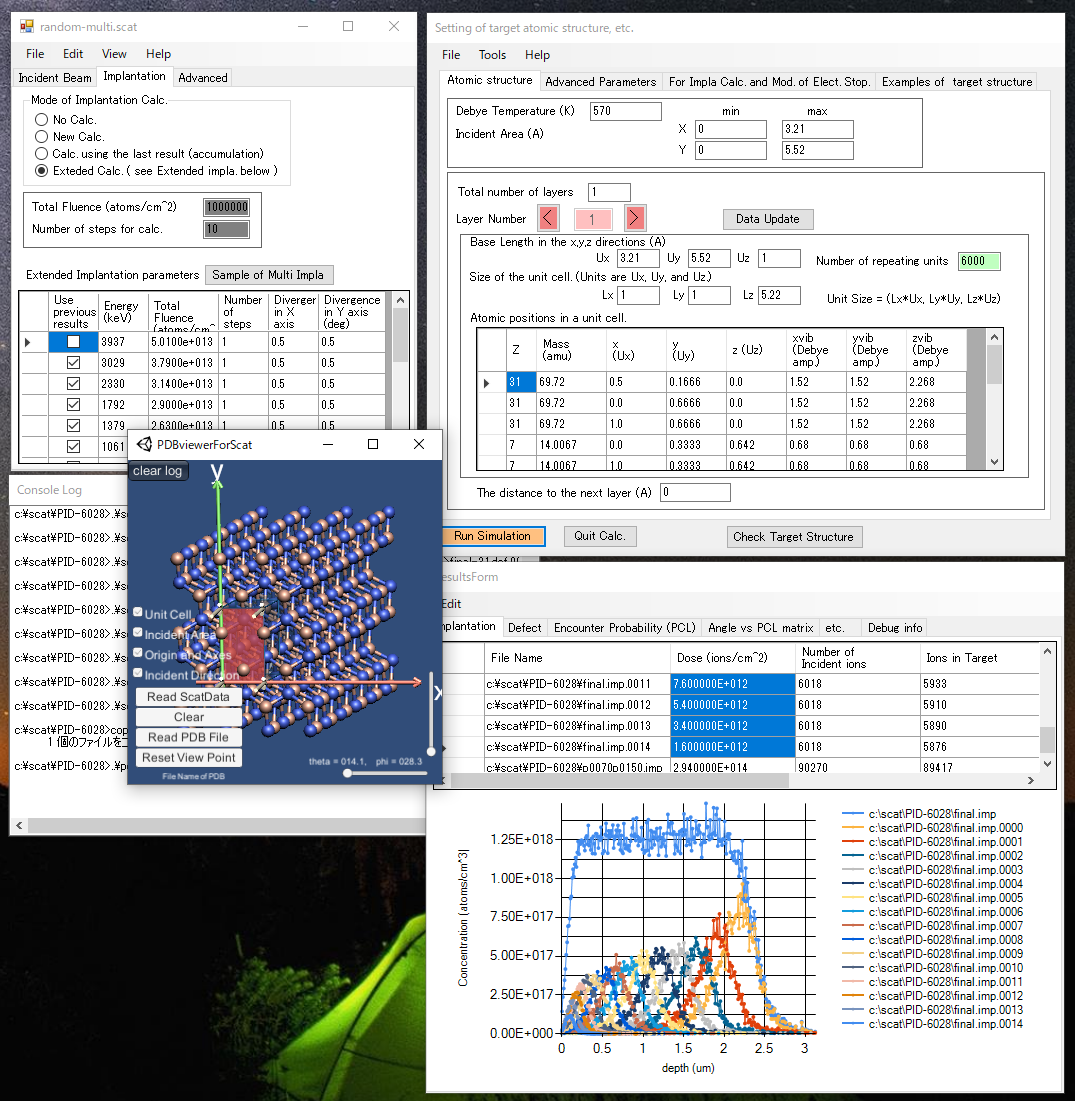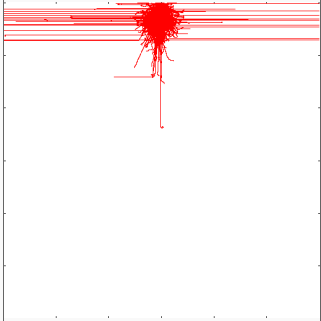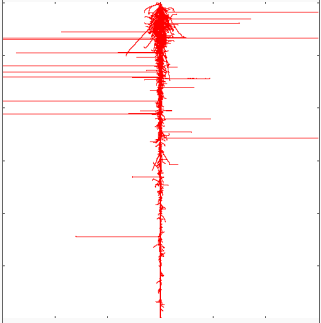scatGUI,ion implantation & channeling simulation software
Author:Tomoaki Nishimura ( t-nishi ( a ) hosei.ac.jp )

Jun 23, 2023
release Version 1.42 Download (MD5 : 289cc4c95f62af426df209f947586a8d)
1. The standard value of the impact-parameter-dependent electronic stopping power was changed to "Se(b) Many-Body".
2. The standard value of the impact-parameter-dependent electronic stopping power for low energy was changed to "no change".
3. Atomic and bond radii can be changed in the molecular viewer.
4. Changed to display the contents of "00ReleaseNote-[E,J].txt" in the description in the aboutBox.
5. The direction of incident ions can now be set with an accuracy of 0.01 degree. Until the previous version, the accuracy was 0.1 degree.
6. The top view and side view of the ion trajectories can be output as bitmap.
7. Fixed a bug that the kinematic factor could not be calculated correctly when the incident atomic mass was heavier than the target atomic mass and the impact parameter was small. This effect was examined by comparing v1.40 and v1.42 and found to be negligible in most cases, but to the extent examined, there is a slight effect for high energy and channeling conditions. Ex. in the case of 960 keV N, P, Al and B on 4H-SiC, the peak depth difference was less than 1% for both channeling and random implantation. However, the peak concentration of defects may be about 10% lower. (ex. 960 keV P -> 4H-SiC, channeling condition). In the case of 20 MeV Al implantation into 4H-SiC along <0001>, the peak depth changed about 2% toward the surface.
8. The depth variation (slices) of particle positions during channeling are now bitmapped and animated using ffmpeg.
-

Fig. 180 keV Mg -> GaN, random implantation
-

Fig. 180 keV Mg -> GaN, channeling implantation
Oct 7,2022
release Version 1.40 Download (MD5 : c9241c30c74796ee502681662e2ed541)
1. Added example of Diamond (111)
Ref.
for Debye temp (1860K) : F. R. L. Schoening and L. A. Vmeulen, Solid State Communications 7 (1969) 15-18,
for average displacement energy (~70 eV) : D. Deigado et al, Journal of Nuclear Materials 419 (2011) 32-38,
for lattice constant (3.567A): S. Shikata et al. , JJAP 57 (2018) 111301.
2. Example for SiC is renewed. detail
Ref. M. K. Linnarsson et al. , J. Appl. Phys. 130 (2021) 075701.
Displacement energy C: 20 eV, Si: 35 eV
Thermal vibration : Debye 1300K,
Si: 0.051A = 1.41×0.0361(debye 1D amp.),
C: 0.057A = 1.03×0.0553 (debye 1D amp.).
Beta : 0.3 -> 0.45
3. Fixed a spelling mistake in scat_st files.
4. The number of decimal places for the unit-related length in the scat_st file generated at the start of a calculation has been changed from the default value to four decimal places.
5. Some cases of incorrect calculations of density and atomic density were corrected (scat.f90).
Cause: Calculations were limited to cases where the unit length in the z direction in scat_st.dat was 0 to 1.0.
When the unit length in the z direction was not 1 and there were atoms actually at z=1, the values were not calculated correctly.
(subroutine calc_computation_calc_dat)
Fix: Corrected so that the values can be calculated correctly even if the unit length in the z direction is other than 1.0.
1.0 -> UNIM(i,3,2)
Scope of effect: Results including defect calculations may differ by 5-10%.
Sample structures that were not affected : GaN-related, Si(001), Si(110)
Sample structures affected : SiC-related, Si(111)
6. In addition to the nuclear and electronic stopping power in two-body collisions,
the contribution of electronic stopping power from many-body is now taken into
account and can be selected as one of the collision coefficient-dependent stopping
power options. (Se(b) Many-Body) detail
7. Se(b) (Many-Body) is now selected as the recommended parameter for impact parameter
dependent stopping power.
8. Se(b) (Many-Body) was selected as examples of a setting for the stopping power of Diamond and SiC.
9. Added the ability to graphically display the directional and positional distributions of the
ion beam after sample penetration.
10. Fixed a bug in the closed-encounter-probability(PCL) calculation that occurs when two or more atoms
of different elements have exactly the same z-coordinate.
11. The beta value of the Diamond samples were set to 0.54.
12. The beta value of the SiC sample were set to 0.45.
13. The number of particles written to ion_penetrated.dat is now limited to 30000. This is because a read
error (memory overflow) occurs when the number of incident particles is large (e.g. angular scan).
14. Added log display ON/OFF function to make it easier to see scrolled out logs. (right-click on a console form)
15. Modified so that the total dose is displayed in exponential form when a file is loaded.
16. No complex implantation calculations are performed during angle scanning, but only one calculation is
performed for each angle, so the label "No Calc." was changed to "No Calc. (simple calc. only)".
17. The angle and depth values corresponding to the mouse cursor position on the PCL matrix color display screen are now displayed numerically.
18. The angle values corresponding to the mouse cursor position are now also displayed numerically in the upper right graph display of the PCL matrix.
Jan 18 , 2022
- release Version 1.38 Download (MD5: ead4105b1d14b2147aa6ed8932586975)
1. Added drag&drop function to ImplaGraph. (We need SIMS-like data where the first and second columns correspond to x(um) and y(atoms/cm^3), respectively.
2. A function to delete files on ImpaGridView was added to the right-click menu.
3. Fixed a bug that sometimes caused scatGUI to fail to start on English Win. ( Changed the AutoScaleMode property of each WinForms from "Font" to "None". )
4. Implemented auto update check feature.
July 9 , 2021
1. Improved the calculation of encounter probability.
2. The 1D vibration amplitudes of the atomic structures of GaN for the examples were changed to the average values of Ga:0.059A and N:0.063A by Xiong & Moss (1997), and the correction factor of the stopping power was changed from 1.0 to 1.2 to reproduce the distribution of random implantation.
(Ref. M. Schowalter et al. Acta Cryst. A65, 227-231 (2009). The average values were calclulated after converting the 2D amplitudes of u11 and u33 in Table 6 to 1D amplitudes.)
3. For reference, Firsov's impact-parameter-dependent stopping power was implemented.
4. Add the option to set the electronic stopping to zero when the ion energy is low (less than a few keV/u).
(In the case of channeling implantation, this option maybe possible to reproduce the experimental values.)
5. Bug fix for quick sort function.
6. The x in Oen & Robinson's electronic stopping exp(-beta * x) can be chosen to be both the impact-parameter(b) and the nearest neighbor distance (r0) (r at Apsis point).
7. The coefficient of Oen & Robinson's electronic stopping coefficient (0.3) can be changed.
(standard value = beta = 0.3/a_screening) (Se(b) = (Ziegler's Se) ×beta^2 ×exp(-beta * b)/(2 Pi) )
8. The inflection point (starting point) in two-body collisions has been the intersection of the straight line of the incident ion and the line perpendicular to it through the target atom in order to simlified the calculation. However, for low-energy ions (below a few keV), the asymptotic deviation after the collision is larger than that of the ideal trajectory in a two-body collision by the Runge-Kutta method. The inflection point (starting point) correction can be obtained by performing a time integration calculation of the two-body collision. In order to improve the simulation accuracy for low energy ion scattering and channeling implantation, the correction can be selected from scatGUI.
References
1. Tomoaki Nishimura and Tetsu Kachi, “Simulation of channeled implantation of magnesium ions in gallium nitride”, Applied Physics Express 14, 116502 (2021). https://doi.org/10.35848/1882-0786/ac2a55
2. Tomoaki Nishimura, Kiyoji Ikeda, and Tetsu Kachi, “Channeled implantation of magnesium ions in gallium nitride for deep and low-damage doping”, Applied Physics Express 14, 066503 (2021). https://doi.org/10.35848/1882-0786/ac039e
3. T. Nishimura, M. Satoh, K. Nomoto, T. Nakamura, T. Mishima, "Site identification of GaN using preferential scattering effect along [1-100]axis", Nuclear Instruments and Methods in Physics Research B 268 (2010) 1942-1944.

